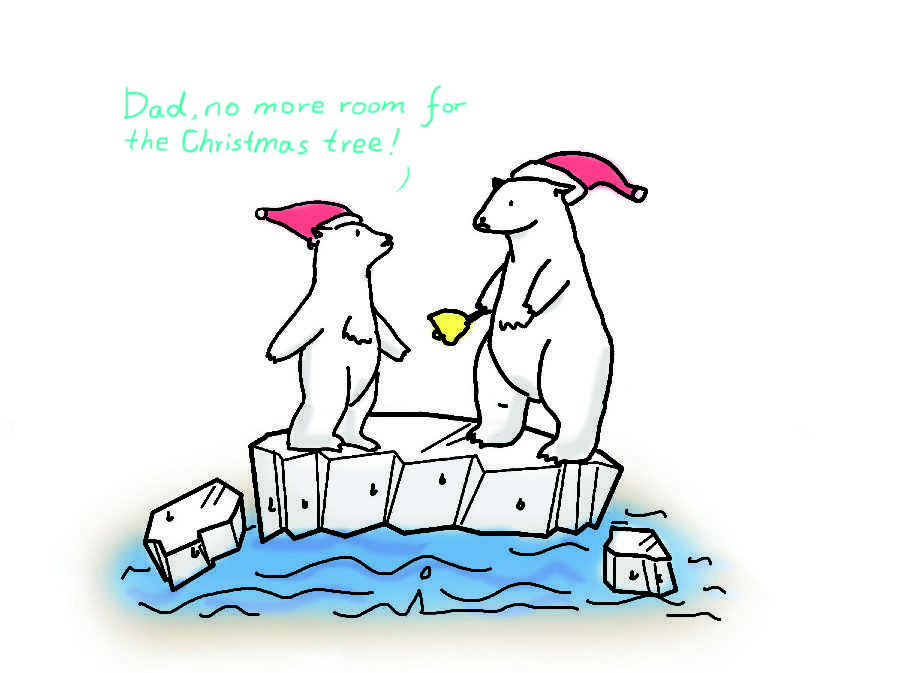Ellingson: Bring on the heat
Illustration: Bolun Li/Iowa State Daily
Opinion: Ellingson 11/12
November 12, 2012
Whether you believe in global warming, increased solar irradiance or that the weather is just going through a natural cycle, there is no dispute that planet Earth is getting hotter.
Since the development of the Industrial Revolution, Earth’s average temperature has increased approximately 1.4 F. The hardest hit areas are those closest to the polar regions, such as northern Alaska and eastern Russia, where they have experienced increased average temperatures as much as 40 to 70 F in the last few decades alone. In Montana, the Glacier National Park consists of 27 glaciers, but that number pales in comparison to the 150 glaciers that were once there in 1910.
One of the biggest environmental issues of recent years has been the rapidly melting polar ice caps, which is expected to shrink from 2.3 million square miles of ice coverage to about 770,000 square miles in a span of 10 years, and the remaining ice will be considerably thinner than it used to be. At this rate, the majority of the region could be ice-free during the summers by the end of 2040.
The climate change is causing environmental issues for people all over the world, including areas as close to us as Alaska and Montana.
The loss of ice is a huge threat for animals such as the polar bears, which depend on the ice as part of their survival. The white, cuddly bears of the north rely on the ice surfaces for hunting, breeding and creating dens. A reduction in ice ultimately means a reduction in their habitat and could mean further endangerment to their species. In addition, seals, walrus and whales in that area have also been changing their feeding and migration patterns to adapt to the climate changes.
But the excess water from the melting has to go somewhere. The melting ice has caused the overall sea levels to rise by as much as 6 to 8 inches. That is enough to potentially cause more frequent severe storms and increased flooding in some coastal areas. It is possible Hurricane Sandy’s severity is related to the recent climate change.
While the direct causes of the increased temperatures are not yet definitive, it is believed humans have created a huge effect on global warming by the 2.3 trillion tons of carbon dioxide being emitted into the atmosphere. Every day, people burn fossil fuels to power their vehicles or provide electricity to their homes and many are not aware of the impacts they’re making on the planet.
There are plenty of ways to reduce your carbon footprint, which is the amount of carbon dioxide emitted into the atmosphere due to the consumption of fossil fuels by an individual.
You can buy a reusable water bottle instead of buying packages of plastic water bottles. Tap water is just as good as bottled water, especially if you buy some sort of filtration system. If you do buy bottled water or any type of beverage that comes in a bottle or can, be sure to recycle them. The same is true for cardboard, paper and other objects. Check the labels on anything you throw away and recycle what you can.
Fluorescent light bulbs use approximately 75 percent less energy than a regular incandescent light bulb. While they might be more expensive to purchase, in the long run they will reduce your energy bill and are better for the environment.
Unplug any electronic device that you aren’t using. This may seem like a hassle, but many devices have a standby mode that draws out power from the outlet even if it’s not turned on. An easy way to do this is to buy a power strip that you can flip the switch and turn off everything completely.
Do not drive if you can help it. Driving has a huge impact on the environment, and it’s better for everyone if you can walk, ride a bike or take public transportation to your destination. This is important for those living on campus who are easily within walking distance of class or can utilize CyRide, which is available to most parts of Ames.
Use cold water when possible. Maybe not for showers, but most loads of laundry can be run using cold water. It takes quite a bit of energy to heat up water for every cycle that runs on a warm or hot setting, and by using cold water, you can save a lot of energy, which lowers your bill in the long run.
These are just a few ways to reduce your carbon footprint, and whether you believe in global warming or not, you cannot deny that these suggestions are better for the environment and most of them will save you money. The efforts we make now will not only benefit you but will improve the lives for many future generations and countless species of animals, such as the polar bear, whose survival is linked to the actions we take today. So everyone needs to do their part and help save our planet.







